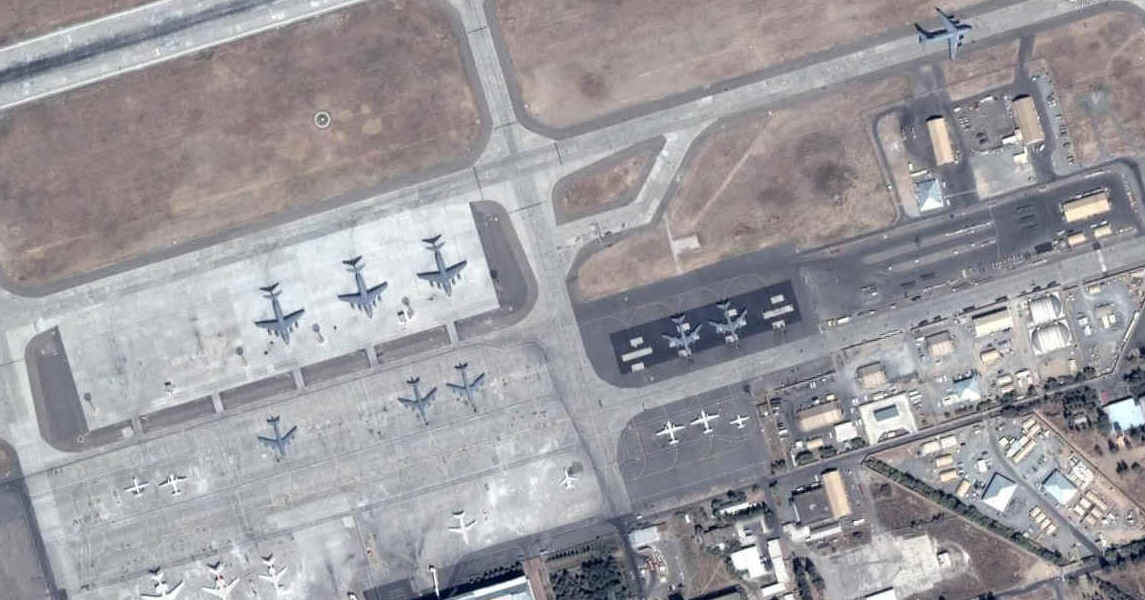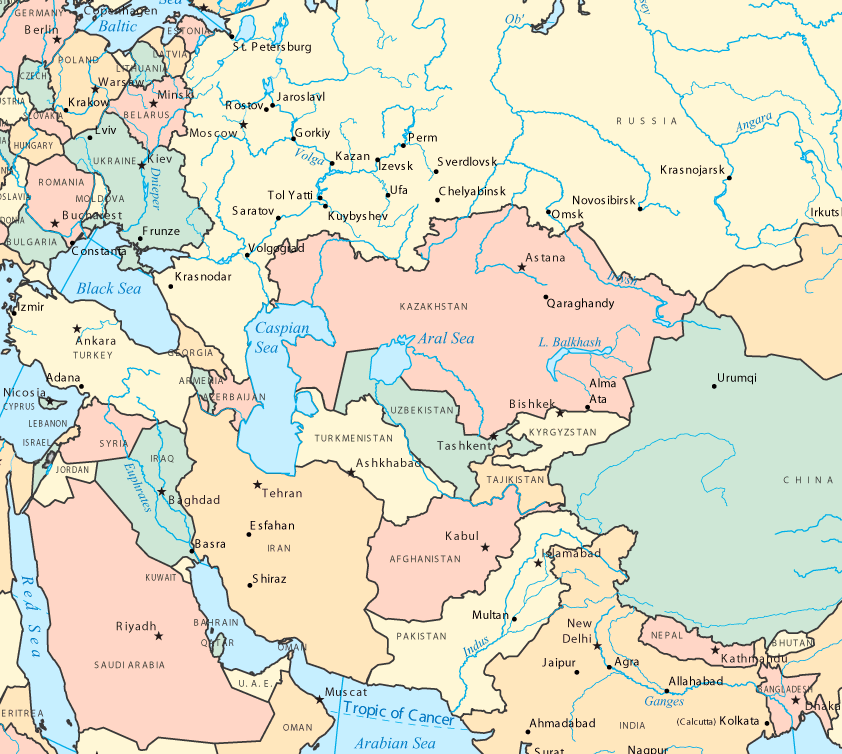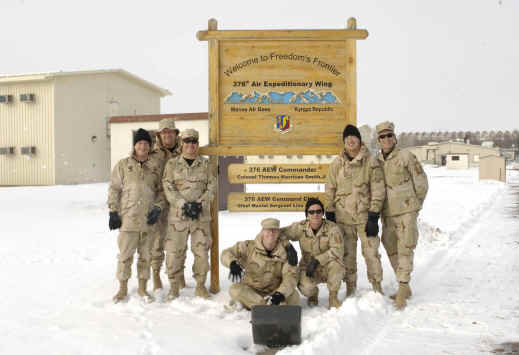After the 9-11 terror attack, the U.S. military focused all efforts on a quick invasion of Afghanistan. Sympathetic nations offered their airfields, and the USAF occupied these expeditionary airbases to support operations in Afghanistan. The Taliban were quickly routed, and the USAF began to improve existing airfields in Afghanistan. As these Afghan airbases became ready, the USAF ended the use of bases in surrounding nations, except operations at the Manas International Airport near the Kyrgyzstan capital of Bishkek, where a new American airbase continues to grow with unlimited war funding and no Congressional oversight. The USAF 376th Expeditionary Wing remains there today with over 1000 airmen and 650 contractor personnel for no apparent reason.
 The USA operates six large airfields
in Afghanistan with long runways to accompany large transports, plus
seven mid-size airfields that can accommodate C-130s. It
no longer needs its airbase at Manas, which is over
400 miles from the northeast corner of Afghanistan, and over 600 miles the
southern region where most of the fighting takes place. This is too far to
provide aerial observation support, timely close air support, or helicopter
operations. However, Kyrgyzstanís vast open airspaces are ideal for fighter
combat maneuvering, so Manas was retained as a playground. After the Taliban
were routed, American and NATO jet fighters arrived and began flying
fighter training missions. These fighter aircraft also flew long-range strike missions
into Afghanistan, even though there were rarely targets to strike. This was
great training with little risk, yet allowed them to earn combat pay and combat
mission credits. These strike missions were the primary cause of civilian casualties that angered the Afghans. Pilots loaded up with bombs
and flew over a hour to an area of possible fighting, but after two more hours of
pointless circling, they wanted to drop their bombs and go home, so they
demanded something to bomb.
The USA operates six large airfields
in Afghanistan with long runways to accompany large transports, plus
seven mid-size airfields that can accommodate C-130s. It
no longer needs its airbase at Manas, which is over
400 miles from the northeast corner of Afghanistan, and over 600 miles the
southern region where most of the fighting takes place. This is too far to
provide aerial observation support, timely close air support, or helicopter
operations. However, Kyrgyzstanís vast open airspaces are ideal for fighter
combat maneuvering, so Manas was retained as a playground. After the Taliban
were routed, American and NATO jet fighters arrived and began flying
fighter training missions. These fighter aircraft also flew long-range strike missions
into Afghanistan, even though there were rarely targets to strike. This was
great training with little risk, yet allowed them to earn combat pay and combat
mission credits. These strike missions were the primary cause of civilian casualties that angered the Afghans. Pilots loaded up with bombs
and flew over a hour to an area of possible fighting, but after two more hours of
pointless circling, they wanted to drop their bombs and go home, so they
demanded something to bomb.
Operating in Russiaís and Chinaís backyard irritated those nations. When they complained about the fighter training and the dubious justification for keeping American troops at Manas, American Generals responded that they had done nothing illegal, and Russian or Chinese threats are proof that friction remains and more fighter aircraft are needed in their inventory. Some people in the Bush Administration loved this drama and hoped to restart the Cold war, further evidenced by American meddling in the former Soviet Republic of Georgia. The Russians and Chinese pressured Kyrgyzstan to oust the American squatters. The Russians made threats, moved MIG fighters to a nearby airbase, and offered economic aid.
Their effort was successful and Kyrgyzstan's President announced in February 2009 that the American airbase must close due to a failure to agree on new lease terms. The Kyrgyz Parliament voted to close the base on February 19 by a vote of 78 to one. The next day an eviction notice was delivered to the U.S. Embassy in Bishkek, requiring the base to be vacated within 180 days. American Generals told everyone that Manas was a key logistics base to support operations in Afghanistan, knowing the reporters are too lazy to consult maps to see that Manas (at Bishkek) is a poor location for an air logistics hub. Aircraft from the Persian Gulf must fly some 500 miles past Afghanistan. Bishkek and Kabul are the same distance for aircraft flying from American bases in Europe, so why divert to Bishkek for an unnecessary layover? It is even further unless aircraft fly over Russia, which wasn't allowed until 2009 and is not always done since permission is required in advance.

It seems that some imperial minded American Generals want to keep their Manas airbase simply because the USA does not have a military base in that region. It doesn't matter that the USA has no vital interests in that remote, unstable area, or any interests at all. The fact that Manas angers the Russians and Chinese is a plus, because hostile comments from those nations provide proof that more ultra-expensive weaponry is needed. These Generals convinced Washington that Manas was vital to the war in Afghanistan, so the USA agreed to pay Kyrgyzstan millions more dollars in each month to keep it open. The USA also agreed that Manas would no longer be called an airbase, but a transit center, and fighter aircraft were banned.
As a result, the USAF continues to waste millions of dollars and millions of man hours each month by diverting transports for unnecessary stops at Manas to justify its existence. The USAF recently proved that over the pole flights are faster, but then aircraft have the range to reach Kabul without stopping at Manas. A big C-5M transport flew from Dover AFB in Delaware directly to Kabul, without stopping at the "transit center" in Manas. This will not become common because there are no emergency landing fields in the Arctic region, and even if a transport manages to land on ice, its passengers would probably freeze before a long range air rescue team reaches them days later.

The problem with fuel availability in Afghanistan provides some justification for Manas. If that is the case, there is no need for inbound transports to divert 500 miles to stop at Manas. They can stop outbound for a hour to refuel for the return flight, but this does not require a USAF base. Passengers can remain on the aircraft while civilian ground crews refuel, just like long-range civilian flights. And it would be far better to negotiate a refueling arrangement at a civilian airbase along the route to Europe, rather than flying 500 miles northeast to Manas. It makes more sense for outbound aircraft to stop at American airbases in the Persian Gulf to refuel more cheaply before continuing to Europe.
Civilian leaders should ask why the USAF conducts so many ultra-expensive aerial tanker missions from Manas to Afghanistan when it has over a dozen airbases in country. A record 493 tanker sorties were flown in July 2011 alone! The reason is because there is no funding limit and tanker pilots earn air medals for "combat" missions while its more fun for fighter pilots to zoom around and tank up rather than standing by on strip alert at an airfield.
American KC-135 airborne tankers now based at snowy Manas can operate from Anglo-American bases in Oman, which are the same distance from Afghanistan as Manas. Arab sheiks in Oman love to sell Americans fuel, and the USA could avoid the dangerous political instability of Kyrgyzstan. The USA would not have to provide millions of dollars in "aid" each month to keep Manas open and could eliminate 1650 airbase support positions. As events of 2009 showed, politics in the region are complex, and the USAF may be ordered to leave yet again, abandoning the millions of dollars it invests to improve the base each year. American leaders should order the USAF to end unnecessary Manas layovers and abandon its Manas playground. This will save a half billion dollars a year and improve relations with Russia, which is important if the U.S. military wants to continue using Russia a supply route to Afghanistan.
Carlton Meyer editorG2mil@Gmail.com
©2011 www.G2mil.com